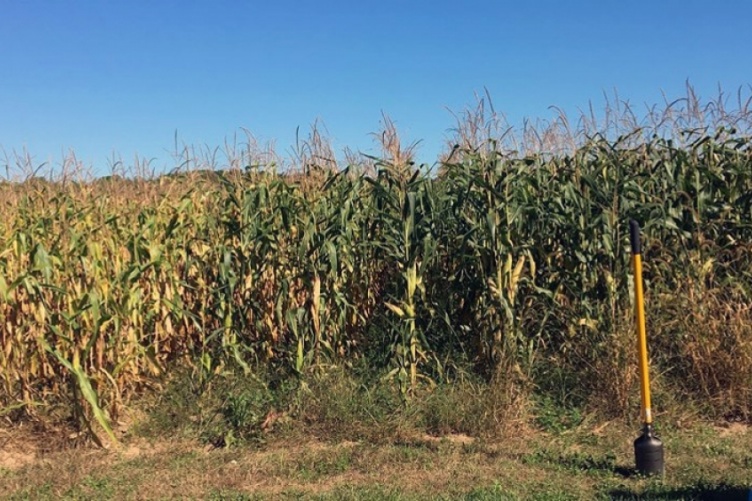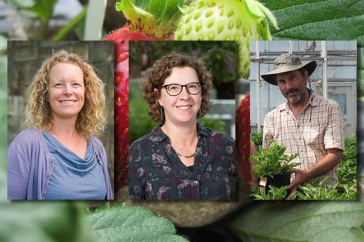
Researchers conduct experiments at the Kellogg Biological Station at Michigan State University. (Credit: Tim Bowles/UC Berkeley)

of corn, even during unfavorable weather conditions such as droughts.
(Credit: Stuart Grandy/UNH)
Rotating crops over time increases the yield of corn, even during unfavorable weather conditions such as droughts, according to new research findings from the NH
Agricultural Experiment Station at the University of New Hampshire and the University of California, Berkeley. The findings demonstrate that diversifying crops may be an effective, long-term strategy for strengthening food production systems globally in the face of a changing climate and environmental degradation.
“The trend towards fewer crops in our agroecosystems is alarming, with massive amounts of U.S. land dedicated to producing corn year after year, or rotating corn one year with soybean the next. We show that increasing yield resilience is a robust outcome over many years and across geographically distinct sites of diversifying rotations by growing a greater variety of crops over time. We expect that our findings are general; that is, they will extend to agricultural sites in New England and other regions, whether in large or small fields, wherever there is concern about sustaining crop yields under variable climates. This research required a massive collaboration and data sharing among university and government scientists, but the heavy lifting paid off,” said experiment station researcher Stuart Grandy, associate professor of natural resources at the University of New Hampshire and director of the UNH Soil Biogeochemistry and Fertility Lab.
The research is presented in the recent issue of the journal One Earth (DOI: 10.1016/j.oneear.2020.02.007). The research was led by Timothy Bowles, assistant professor of agroecology at the University of California, Berkeley, started while he was a postdoctoral researcher in Grandy’s lab. He now directs the Berkeley Agroecology Lab.
Over the last two decades, farmers in the central United States have moved toward monocultures – growing just one crop at a time, sometimes for years in a row. This is especially true for corn. While this may increase profits in the short term when markets are favorable for corn, such as during the biofuel boom, the long-term impact can be profound.
“Monocultures and short two-crop rotations often require more nonrenewable inputs than more complex rotations. Monocultures also contribute to well-documented negative environmental consequences. Here, we show that loss of crop rotational diversity can undermine resilience to stressful conditions, possibly contributing to the observed increases in weather sensitivity of central U.S. corn production,” Bowles said.
Researchers analyzed long-term crop yield data at 11 locations across the United States and Canada to assess how crop diversification affects corn yields in intensively managed grain systems. Crop rotations that are more diverse increased corn yields over time and across all growing conditions an average of 28 percent, including 23 percent in favorable weather conditions. Notably, crop rotations that are more diverse also showed strong, positive effects of 14 percent to 90 percent on yield from a wide range of sites, even under unfavorable weather conditions. Drought and excess moisture were the most common sources of climate stress.
Specifically, the researchers found that crop rotations including crops like alfalfa, spring barley, corn, oats, red clover, rye, sorghum, timothy, hairy vetch, and winter wheat resulted in substantially higher corn yields over time than planting only corn or corn and one other crop.
Scientists theorize improved soil health, reduced plant diseases, pests, and weeds may explain the “rotation effect” on corn yield. More diverse crop rotations also have been found to improve nitrogen retention in soil and boost the supply of nitrogen available to plants during critical periods.
“Increasing crop rotation diversity could help mitigate the impacts of more frequent and intense droughts and heat waves that will likely affect corn production, farmers’ livelihoods, and the food system,” Grandy said. “Systematic approaches to environmental sustainability and yield resilience like diversifying crops are a central component to reduce risk and should inform agricultural policies. “
Other research collaborators include Maria Mooshammer and Yvonne Socolar, University of California, Berkeley; Francisco Calderon, USDA-ARS Central Great Plaines Research Station; Michel Cavigelli, USDA-ARS Sustainable Agricultural Systems Laboratory; Steve Culman, Ohio State University; William Deen, University of Guelph; C.F. Drury, Agriculture & Agri-Food Canada; Axel Garcia y Garcia and Jeffrey Strock, University of Minnesota; Amelie Gaudin, University of California, Davis; W. Scott Harkom, Pennsylvania State University; R. Michael Lehman and Shannon Osborne, USDA-ARS North Central Agricultural Research Laboratory; G. Phil Robertson, Michigan State University; Jonathan Salerno, Colorado State University; and Marty Schmer, USDA-ARS Agroecosystem Management Research Unit.
This material is based upon work supported by the NH Agricultural Experiment Station, through joint funding of the National Institute of Food and Agriculture, U.S. Department of Agriculture, under award numbers 1020144, 1007001, and 1002164, and the state of New Hampshire.
Founded in 1887, the NH Agricultural Experiment Station at the UNH College of Life Sciences and Agriculture is UNH’s original research center and an elemental component of New Hampshire's land-grant university heritage and mission. We steward federal and state funding, including support from the USDA National Institute of Food and Agriculture, to provide unbiased and objective research concerning diverse aspects of sustainable agriculture and foods, aquaculture, forest management, and related wildlife, natural resources and rural community topics. We maintain the Woodman and Kingman agronomy and horticultural research farms, the Macfarlane Research Greenhouses, the Fairchild Dairy Teaching and Research Center, and the Organic Dairy Research Farm. Additional properties also provide forage, forests and woodlands in direct support to research, teaching, and outreach.
-
Written By:
Lori Wright, '06G | NH Agricultural Experiment Station | lori.wright@unh.edu | 16038621452



















































